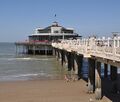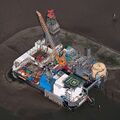Marine architecture
From The Right Wiki
(Redirected from Water transport infrastructure)
Marine architecture is the design of architectural and engineering structures which support coastal design, near-shore and off-shore or deep-water planning for many projects such as shipyards, ship transport, coastal management or other marine and/or hydroscape activities. These structures include harbors, lighthouses, marinas, oil platforms, offshore drillings, accommodation platforms and offshore wind farms, floating engineering structures and building architectures or civil seascape developments. Floating structures in deep water may use suction caisson for anchoring.[1][2][3][4][5]
See also
- Cofferdam – Barrier allowing liquid to be pumped out of an enclosed area, a temporary water-excluding structure built in place, sometimes surrounding a working area as does an open caisson.
- Offshore geotechnical engineering – Sub-field of engineering concerned with human-made structures in the sea
- Civil engineering – Engineering discipline focused on physical infrastructure
- Marine engineering – Engineering and design of shipboard systems
- Ocean engineering – Engineering and design of shipboard systems
- Oceanography – Study of physical, chemical, and biological processes in the ocean
- Earth materials – Naturally occurring materials found on Earth
- Floating wind turbine – Type of wind turbine
- Geotechnical engineering – Scientific study of earth materials in engineering problems
- Geotechnical investigation – Work done to obtain information on the physical properties of soil earthworks and foundations
- Geotechnics – Scientific study of earth materials in engineering problems
- Ocean – Body of salt water covering most of Earth
- Offshore construction – Installation of structures and facilities in a marine environment
- Offshore (hydrocarbons)
- Submarine pipeline – Pipeline that is laid on the seabed or below it inside a trench
- Subsea – Technology of submerged operations in the sea
- Subsea production system – Wells located on the seabed
- Wellhead – Component at the surface of a well that provides the structural and pressure-containing interface
Photo gallery
-
University of Maine's Floating wind turbine VolturnUS 1:8 was the first grid-connected offshore wind turbine in the Americas.
-
Victorian pier at Clevedon, Somerset, England
-
The pier of Blankenberge, Belgium
-
Huntington Beach Pier, California
-
A typical Finnish pier with a table, chair and ladders for swimmers in Joutsa, Central Finland
-
Duxbury Pier Light in Plymouth harbor.
-
Aerial view of a typical marina (harbor dredge and lighthouse in lower right)
-
Oil platform P-51 off the Brazilian coast is a semi-submersible platform
-
An oil drilling platform off the coast of Santa Barbara, CA
-
Oil platform Mittelplate includes an accommodation platform.
-
Harbour cranes unload cargo from a container ship at the Jawaharlal Nehru Port in Navi Mumbai, India.
-
Oosterscheldekering sea wall, the Netherlands.
-
One of the three movable barrier sections of the Oosterscheldekering
-
The Saipem 7000, a semi-submersible crane vessel equipped with a J-lay pipe-laying system.
-
The Solitaire, one of the largest pipe-laying ships in the world.
References
- ↑ Marine Architecture and Engineering Careers
- ↑ Study.com, Marine Architecture Degree Program Overviews
- ↑ History of the University of Michigan, Naval Architecture & Marine engineering
- ↑ U.S. Department of Transportation, Naval Architecture: Past, Present and Future
- ↑ A History of Naval Architecture, By John Fincham
External links
- File:Commons-logo.svg Media related to Marine architecture at Wikimedia Commons






